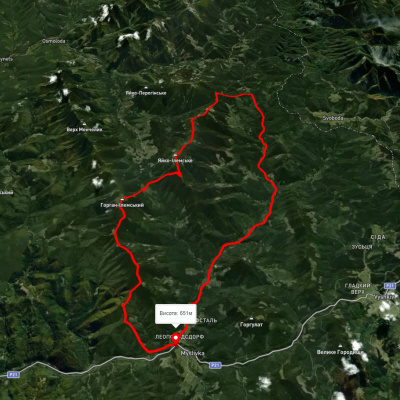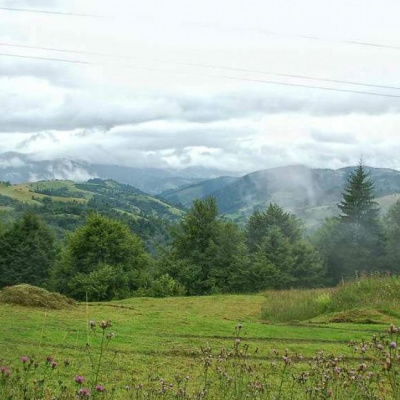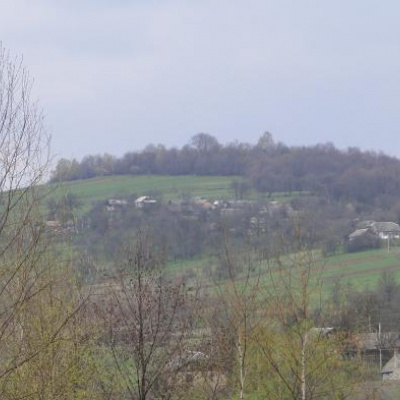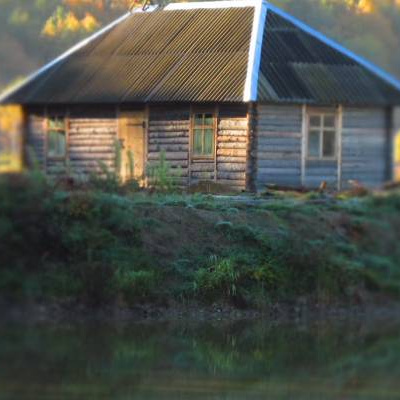Dolyna district
Dolyna district is a district of Ukraine in the northwestern part of Ivano-Frankivsk region. The population is 69,851 people (as of August 1, 2013). The area is 1248 km². The district center is the town of Dolyna. It was formed on January 17, 1940. Among the largest rivers flowing through the district are Svicha, Mizunka, Luzhanka. The northern part of the district is located in Predkarpattia, within the Prysmichanska ridge. To the south are the Pryvododilni (Inner) Gorgany. The main tourist locations (settlements) of the district are: Bukovets, Vyshkiv, Dolyna, Bolekhiv, Vyhoda, Hoshiv, Staryi Mizun, Velyka Turya, Bubnyshche, Myslivka.
The town of Dolyna was founded in the second half of the tenth century. The settlement of these lands was to some extent due to the presence of salt deposits among the dense forests. The first mention of Dolyna is associated with the reign of Polish King Władysław Jagiełł. During several decades of the sixteenth century, Dolyna grew economically due to increased salt production and revitalized trade. In 1525, the town was granted the Magdeburg Law, which introduced self-government and allowed residents to make salt, hold trades, and fairs.
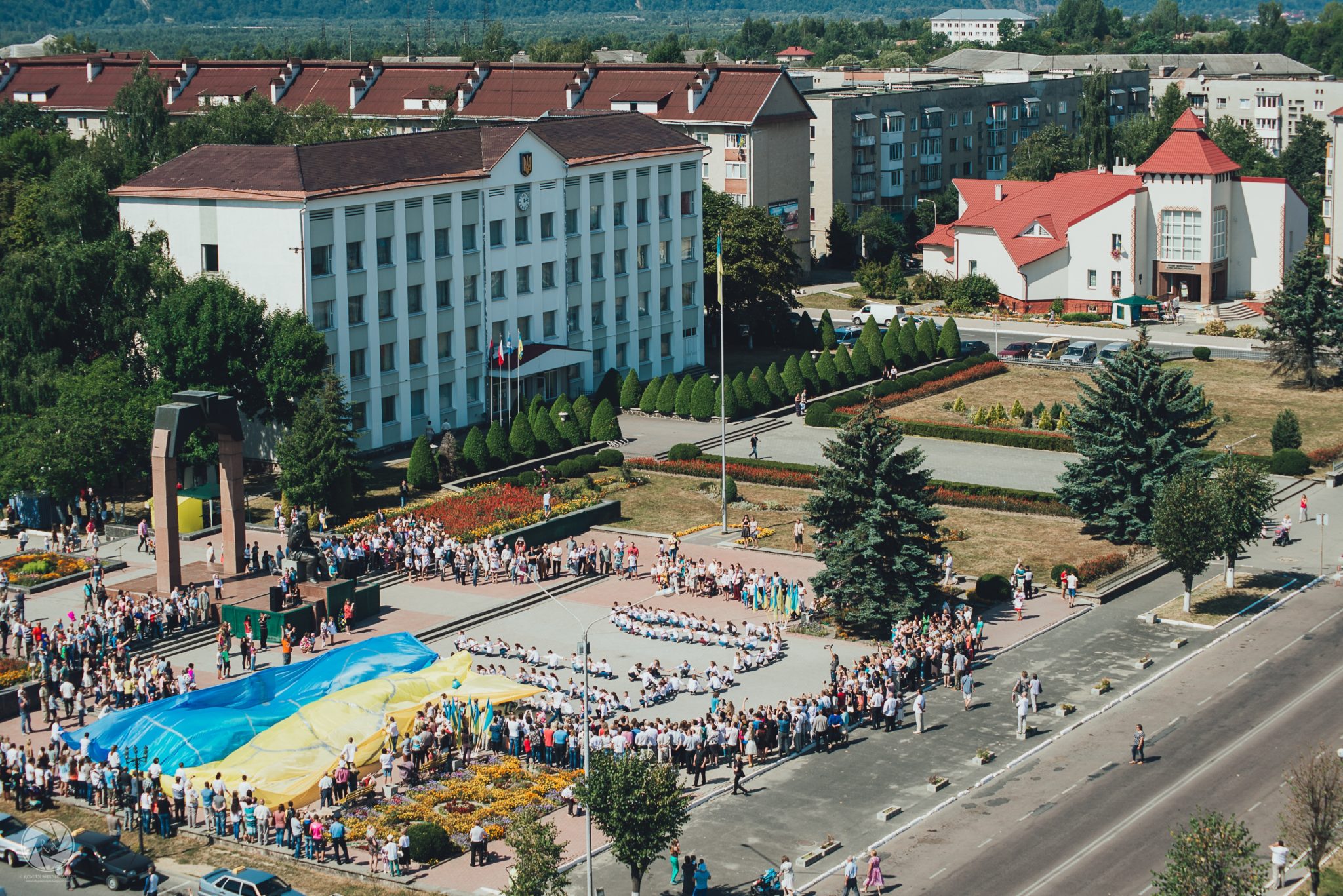
In the XVI-XVII centuries, Dolyna suffered from Tatar attacks more than once. The town suffered special destruction in 1594. For defense purposes, a castle was built in Dolyna and ramparts were built. The remains of these ramparts near Zamchyshche have survived to this day. Other settlements emerged and developed near Dolyna, where salt springs were also discovered. This is how Trostianets, Solukiv, Sloboda-Dolyna, Rakiv and others appeared.
The oldest town in the district is Bolekhiv. The first written mention of "Bolekhiv lands" dates back to 1371. In 1546, the first enterprise, a saltworks, was built in Bolekhiv, on the Stara Banya. Other ancient settlements include the village of Hoshiv (1469), the village of Mizhrichchia (1371), and the village of Tysiv (1464).
The largest river in the district is the Svicha River, which originates from the Vyshkivsky Gorgany ridge at an altitude of 1155 meters. The total length of the river is 167 km. The second largest is the Myzunka River, which begins behind the village of Sida (near Vyshkiv). The river is 51 km long. It flows into the Svicha River in the village of Vyhoda. The Luzhanka River also flows through the Dolyna district, with a length of 29 km. Smaller rivers include the Turyanka River, the Sivka River (a tributary of the Dniester), and the Sadzhavka River.
All the rivers of Dolyna district belong to the Dniester River basin and are mountain rivers. These rivers are characterized by an unstable level regime. The water can rise by 3-4 meters. There are picturesque waterfalls: Mizunsky waterfalls, Pravich, Gurkalo Luzhansky, Gurkalo Lipovsky.
There are no large natural lakes in the area. One of the largest is Dolyna Lake, which covers an area of 25 hectares. The average depth of the reservoir is 2.5 meters. Water reserves in the lake are about 600 thousand cubic meters. There are many artificial reservoirs, ponds and lakes in the area, which are used very little, mainly for recreation. Almost no commercial fish is grown.

Forests occupy a significant part of the district's territory. The Vyhoda State Forestry Enterprise and the Dolyna Specialized Interfarm Forestry Enterprise organize the main felling and sanitary felling. The mountainous Carpathian forests are rich in natural berry plants: strawberries, raspberries, blackberries, blueberries, lingonberries, and rich fauna (deer, bears, roe deer, lynxes, martens, etc.).
Nature reserve fund
- Botanical reserves: Zhydovets;
- Landscape reserves: Bovkoty, River Svicha with its tributary Mizunka, Sadzhavsky, Tsapove;
- Forest reserves: Ilma, Marina.
- Ornithological reserves: Four ash trees, Shevchenkivskyi.
- Protected tracts: Berezina, Gatchin Zvir, Grehit, Dolishne, Dubove, Kichera, Kropyvnyk-1, Kropyvnyk-2, Magura, Magura-1, Magura-2, Makohinka, Nadiyiv, Nyzhniy and Verkhniy Staretsky, Pid gai, Pidlis, Pesok, Pianula, Rakhynia, Rychiv Potik, Razkoly, Roztochanske, Sichka, Sobol, Tarasivka, Peatland, Arshytsia tract, Ukerna tract, Yayko tract, Chorna Sigla.
- Botanical natural monuments: Vysoka Hora, Goshivskyi marshland, Hooks tract, Long Bridge, Dovzhanka, Douglasia, Standard beech-larch plantation, Standard larch plantation, Standard fir plantation, Kropyvnyk, Osiy (of national importance), Pravych-1, Pravych-2, Weymouth pine, Cedar pine, Crimean pine.
- Hydrological natural monuments: Lysak Marsh (national importance), Shyrkovets Marsh (national importance).
- Complex natural monuments: Lysyi Potik.
- Dendrological parks: Maloturyansky.
The settlement of these lands was to some extent due to the presence of salt deposits among dense forests. The Ascension Monastery was built here, where monks began writing a kind of chronicle of Dolyna in 1112. In 1525, the city of Dolyna was granted the Magdeburg right. One of the oldest settlements of the district is Hoshiv (1469).
In 1791, Dolyna was deprived of its old privileges and the title of "Free Royal City". An important event in the life of the population of Galicia was the complete abolition of serfdom in 1848. This event was preceded by an uprising in Hungary and revolts in the Czech Republic, Slovakia, Galicia, and Bukovyna. That year Franz Joseph came to the throne.
On December 3, 1920, Dolyna district was incorporated into the Stanisławski Voivodeship of the Polish Republic. On November 27, 1939, Dolyna district was included in the newly formed Stanislav region. On January 17, 1940, Dolyna district was liquidated and divided into Bolekhiv, Vyhoda, Dolyna, and Rozhnyativ districts. The Dolyna district was formed by a decree of the Presidium of the Supreme Soviet of the Ukrainian SSR on January 17, 1940, from three components of the Dolyna district: the city of Dolyna and the gminas of Rakhyn and Broshniuv.
By a decree of the Presidium of the Supreme Soviet of the Ukrainian SSR on October 23, 1940, village councils were transferred:
- Bolokhivska from the Voynyliv district
- from Kalush district - Kadobnytsia
- from Vyhoda district - Malo-Turyanska and Yavorivska
- from Dolyna district to Rozhnyativ district - Svarychivska.
By a decree of the Presidium of the Supreme Soviet of the Ukrainian SSR on June 6, 1957, Vyhoda district was annexed to Dolyna district. By the Decree of the Presidium of the Supreme Soviet of the Ukrainian SSR on December 30, 1962, the district was included in the Kalush industrial district, but by the Decree of the Presidium of the Supreme Soviet of the Ukrainian SSR on January 4, 1965, the district was formed again.
The tourism industry in Dolyna district is underdeveloped. There are plans to develop this industry, including the construction of a tourist center in the village of Myslivka, as well as the construction of a ski resort.
Places of worship
- Church of the Nativity of the Blessed Virgin Mary (1896), Dolyna;
- Church of theNativity of Anna Maria (1838), Dolyna;
- Church of the Heart of Jesus and the Heart of Mary, Dolyna;
- Hoshiv Monastery of the Basilian Fathers and the Church of the Transfiguration of the Lord on Yasna Hora (1570), Hoshiv village;
- Monastery of the Sisters of the Holy Family, Hoshiv village;
- Church of the Assumption of the Blessed Virgin Mary (1686), village of Patsykiv;
- Church of the Holy Trinity (XVIII century), village Maksymivka;
- Church of the Ascension (1867), village of Lypa;
- Church of St. Paraskeva (1642), Velyka Turya village;
- Surgical building of the central district hospital (1902), Dolyna;
- The building of the district court (early XX century), and after the war the building was a barracks of a military unit (Dolyna);
- Magistrate in the thirteenth and nineteenth centuries was a generalized name (according to Magdeburg law) for the bodies of the bourgeoisie's local government and court. The magistrate in Dolyna consisted of an elected mayor and councilors who formed a board. The head of the council later became known as the burmistro.
- The building of the military enlistment office (1920), Dolyna;
- Synagogue (1897), now a house of prayer for the Evangelical Christian Baptist community, Dolyna;
- The building of the Polish gymnasium of 1904-1908 (currently used by the gymnasium №1), Dolyna;
Museums
- Museum "Boykivshchyna", Dolyna, 2a V. Chornovil str. +38 (03437) 2-79-00.
- Museum of Oksana Hrytsia Dolyna. Dolyna, 18 A. Mickiewicz str. +38 (03437) 2-62-30, +38 (097) 249-20-69.
- Z. Krasivsky Museum, Vytvytsia village +38 (03437) 3-54-47, 3-53-23.
- Ivan Franko Museum, Lolyn village, +38 (03477) 5-32-84, 5-35-32, 5-33-48.
- Museum of the History of Bolekhiv named after R. Skvoriy, 9 Sichovykh Striltsiv St., Bolekhiv, +38 (03437) 3-45-00.
- Robert's Bunker on Yavorina Mountain near the village of Lypa;
- Museum of Heritage of Dolyna District, village Vyhoda;
- Saltworks (nineteenth century), Dolyna, 1 May street;
- Museum-hideout of the rebel victory, Dolyna.
Natural monuments
- Mizun waterfalls, near the village of Novyi Mizun;
- Dovbush's rocks, Bubnyshche village;
- Dead Lake (karst), to the west of Dovbush Rocks at an altitude of 780 m;
- Shyrkovets swamp near Novyi Mizun.
Mineral springs
- "Horyanka" (similar in effect to Truskavets "Naftusya"), Novyi Mizun village;
- Sanatorium "Pearl of the Carpathians", the village of Vyhodivka.
- Carpathian tram. A unique journey on a narrow-gauge railroad built in 1898 for production needs. Hiking trails along the Mizun railway have been developed and are operating along the route Vyhoda-Mizun-Dubovyi Kut, Mendunok, Sobol and to the foot of Mt. Magura (1354 m above sea level). During the trips (depending on the season), you can pick mushrooms and berries, swim in the Mizun waterfall, taste water from mineral springs, etc. To book excursions, +38 (03477) 6-13-34, +38 (050) 373-24-75, +38 (067) 342-83-89.
- The Eastern Carpathian tourist route runs through Dolyna district: Torun Pass - Mt. Vyshkivsky Gorgan - traverse of Mt. Maly Gorgan - Mt. Yavorova Kichera - valley of the Svicha River - Solotvynka meadow - Mt. Moloda - Kruhle tract - Hrofyansky pond - Mt. Hrofa - Mt. Parenky - Mt. Popadia, marked in red.
- с. Vyshkiv - Mt. Zalom - traverse of Mt. Vyshkivskyi Horhan - Synevyr Lake, marked in blue.
- с. Myslivka - Mt. Kamyanka - Mt. Maly Pustoshak - Mt. Velykyi Pustoshak, marked in yellow.
- с. Myslivka - g. Gurgulat, marked in green.
Які туристичні (пішохідні) маршрути проходять через/біля Dolyna district?
Пропонуємо пройти такі туристичні (пішохідні) маршрути через/біля Dolyna district: Маршрут на г. Щавна, с. Мислівка, через г. Яйко-Ілемське, г. Горган-Ілемський до с. Мислівка, На Горган Ілемський, с. Мислівка, через г. Вел. Пустушак, пол. Німецька, г. Горган Ілемcький до с. Осмолода, с. Мислівка – г. Горган-Ілемський – с. Мислівка, с. Мислівка, через г. Яйко Ілемське, г. Горган Ілемський до с. Мислівка

